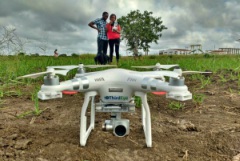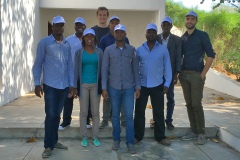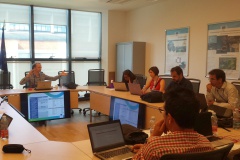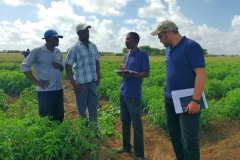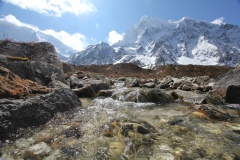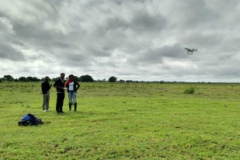Categorie: Uncategorized
14 september 2016
ThirdEye gepresenteerd als innovatieve technologie in Mozambique
Van 29 augustus tot 4 september vond in Maputo de International Trade Fair FACIM plaatst. Op deze beurs verzorgde de Nederlandse Ambassade een Holland paviljoen waar verschillende Nederlandse organisaties zich presenteerden aan de Mozambikaanse markt. Dit paviljoen stond op woensdag 31 augustus in het teken van het FACIM WATER EVENT ‘The adaptation of innovative technologies...
25 augustus 2016
FutureWater Co-Convenes Session at the World Water Week
The International Centre for Integrated Mountain Development (ICIMOD), FutureWater and Statkraft convene a session on Mountains, glaciers, and hydropower in a changing climate at the World Water Week, organized in Stockholm 28 August – 2 September. This session will highlight the role of mountains in providing water, food, and energy for sustainable growth using examples...
7 augustus 2016
First week of successful training in Water Resources Modeling for ARA-Sul and ARA-Norte, Mozambique
During the week of 11-15 July, training in Water Resources Modeling (using SPHY) was provided to ARA-Sul and ARA-Norte (water boards) in Mozambique. This training was funded by NUFFIC’s Tailor-Made Training Programme, which is part of the Netherlands Fellowship Programmes (NFP II), and is specifically meant to enhance the overall functioning of an organization by...
7 juli 2016
FutureWater organizes coordination meeting for IMPREX project at EU Joint Research Centre
On 27 and 28 June, IMPREX partners working on agriculture and droughts gathered in the premises of the EU Joint Research Centre (JRC) in the Italian city of Ispra. The two-day meeting provided an opportunity to review recent progress, coordinate future actions, and to establish links with relevant activities and laboratories of the JRC. The...
5 juli 2016
Identifying and designing business models for the ThirdEye project in Mozambique
How to be a commercial business, and at the same time reach out to the rural poor and enable them to increase their food production and improve their livelihoods? The key ingredient for success is getting the right business model! Agricultural Business Developer Jelle van den Akker investigated the transition of the ThirdEye project from a...
25 mei 2016
Promotieonderzoek: Meer water in Aziatische rivieren door klimaatverandering
Tekst deels van Universiteit Utrecht Op vrijdag 27 mei verdedigt Arthur Lutz zijn proefschrift dat het resultaat is van een gezamenlijk promotieonderzoek van FutureWater en de Universiteit Utrecht. Hij concludeert dat klimaatverandering zorgt voor meer regen en smeltwater, en dus voor meer water in de Aziatische rivieren. Meer dan een miljard De meeste grote rivieren...
19 mei 2016
Lezing Dr. Walter Immerzeel – IceSpy: drones om gletsjers in de Himalaya te analyseren
Tijdens de vijftigste editie van het internationale rondreizende Campus Party, 25 tot en met 29 mei is de Jaarbeurs in Utrecht, zal Dr. Walter Immerzeel een keynote lezing geven. De lezing gaat over de gevolgen van klimaatverandering op de gletsjers en ijsvelden in de Himalaya op een hoogte van 5000 meter en hoger. Zo’n 1.5...
19 mei 2016
Dr. Walter Immerzeel ontvangt Vidi-subsidie
Dr. Walter Immerzeel, hydroloog bij FutureWater en wetenschapper van de Universiteit Utrecht, heeft van NWO een Vidi-financiering toegekend gekregen van 800.000 euro. In totaal dienden 572 onderzoekers in Nederland een aanvraag in, waarvan NWO er uiteindelijk 87 heeft gehonoreerd. De Vidi-subsidievorm is gericht op excellente onderzoekers die na hun promotie al een aantal jaren succesvol...
29 april 2016
ThirdEye: Training new Flying Sensor operators in Mozambique
A key factor in enabling an increase and efficiency in food production is providing farmers with relevant information. Such information is needed as farmers have limited resources (seed, water, fertilizer, pesticides, human power) and are always in doubt in which location and when they should supply these resources. Interesting is that especially smallholders, with their...
28 april 2016
FutureWater contributes to the EGU General Assembly 2016
Results of several ongoing projects of FutureWater were being disseminated among a large group of scientists last week during the General Assembly 2016 of the European Geosciences Union (EGU). The EGU General Assembly was held at the Austria Center Vienna (ACV) in Vienna, Austria, from 17 to 22 April 2016. It is the largest conference on the...
